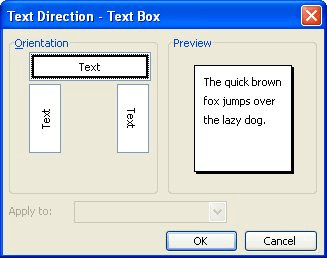Lesson 17: Changing Your Default Settings in Word
Center the text vertically between the top and bottom margins. Select the text that you want to center. On the Layout or Page Layout tab, click the Dialog Box Launcher in the Page Setup group, and then click the Layout tab. In the Vertical alignment box, click Center. In the Apply to box, click Selected text, and then click OK. Nov 24, 2020 Click your mouse on the Change Text Direction tool on the Tables and Borders toolbar. Word changes the orientation of the text in the cell. Continue clicking on the Change Text Direction tool until the orientation is exactly as you want it. WordTips is your source for cost-effective Microsoft Word training. (Microsoft Word is the most popular. Click Text Direction in the Alignment section of the Layout tab. Each time you click Text Direction, a different direction is applied. Keep clicking the button until the desired direction is applied. You can also right click on the selected text in the table cells and select Text Direction from the popup menu to change text direction in a table. The Text Direction button in the Alignment group changes the way text reads in a cell or group of selected cells. Normally, text is oriented from left to right. By clicking the Text Direction button once, you change the text direction to top-to-bottom. Click the button again and direction is changed to bottom-to-top. To rotate text inside a table, drag to select a group of cells. Right-click within the selection and click Text Direction. In Word 2003 or earlier, select Format → Text Direction from the top menu instead.

/en/word-tips/how-to-create-a-bibliography-or-works-cited-page-in-word/content/
Changing your default settings in Word
There may be certain settings in Word that get on your nerves, like default settings that you find yourself changing over and over—the paragraph spacing, the font size—each time you start a new document.
Maybe you prefer a different font style instead of the default Calibri. Maybe you like all of your documents to have narrower margins so you can fit more information on the page. Maybe you even work for a company that has very specific document standards—regarding the color scheme or layout—and you're tired of changing these settings every time.
Luckily, you can customize many of the default settings in Word. You just have to know where to look.
Cached
Using Set as Default
You can't change the default settings for everything in Word, but there are certain tools and features that give you this option. Popular examples include:
- Font
- Paragraph spacing
- Line spacing
- Margins
- Page orientation
To find out if you can customize the default settings for a certain element, look for an arrow in the bottom-right corner of the group. This will open a dialog box where you can access all of the basic settings, plus some more advanced ones that you won't find on the Ribbon.
Next, look for a button near the bottom of the dialog box that says Set as Default. All you have to do is click this button, and Word will assign your current settings—like the font or font size you've chosen—as the new default for this particular element.
Finally, Word will ask whether you want to set this as the default for this document only, or for all documents based on the Normal template (in other words, all documents in the future). Choose the second option, and Word will use these settings from now on.
How To Set Text Direction In Microsoft Word - My Microsoft ...
If you don't have a lot of experience with Word, you may want to stick with the original default settings—any changes you make will be permanent, unless you change them back manually. But for more experienced users, this can be a great way to set up Word exactly the way you want.
If you are experiencing a problem getting your default changes to save, it might be an issue with your computer or your copy of Word. For help, we recommend visiting Microsoft's support site.

/en/word-tips/how-to-create-forms-in-word/content/